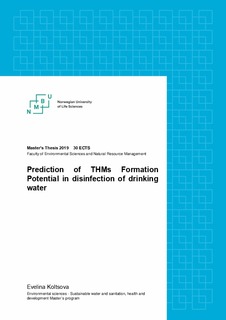| dc.description.abstract | Many people are exposed to disinfection by-products through centralized drinking water supplies around the world. There is a big concern about the possible relation between DBPs formation and cancer cases. THMs and HAAs are the main groups of DBPs, which in general form 80 – 84 % of total DBPs. DBPs are the result of a chemical reaction between applied disinfection reagent and naturally occurred organic matter in the water. However, the regulation of some specific compounds (NDMA, HBQs, etc.) will be strictly focused in the future, due to toxicological and cancerogenic data.
Many disinfectants are used, which have shown the drastically reduction of the DBPs compared to chlorine. Some DWTPs install additional treatment step for removal of DBPs precursors.
Finally, treatment with pre-ozonation is an option for disinfection, which may increase disinfection effectiveness and decrease DBPs formation.
This study evaluated various ozone dose and contact time in combination with chlorination under different water quality parameters. Water samples from nine lakes, which are used for drinking water supply, across the Oslo region (Norway) with differing in water quality (pH, NOM, TU, color, conductivity) were collected. Each water sample was treated with ozone for times 15 min, 45 min, and the ozone doses 1.5 mg/l, 3 mg/l. In addition, control samples that were not treated with ozonation were analyzed. After the ozonation, the water samples were dosed with 2 mg/l of chlorine. Additionally, the raw water quality effect on THMs formation was investigated. The number of correlations between water parameters and THMs formation was described based on conducted experiments.
This research has shown that raw water quality plays a crucial role in further THMs formation. In turn, THMs formation has a strong correlation with TOD (93%), TOC (92%) and UV254 (91%), respectively.
Additionally, the use of ozone with a dose of 1.5 mg/l during constant contact time tends to reduce THFMFP. This reduction was ranging from 10 to 40 %, depending on the raw water quality parameters. Increasing the ozone dose helps to reduced THMs formation further.
Based on achieved results, thee THMs predictive models were investigated for different water parameters and disinfection conditions.
A review of information related to DBPs regulations and an overview of disinfection processes as well as past research data presented in Chapter 2. A detailed description of the current experimental design and analytical methods used for ongoing research is presented in Chapter 3. Following the content, Chapter 4 shows the results of conducted experiments followed by the conclusion, references, and recommendation for further research. | nb_NO |

